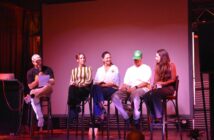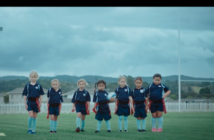Why is it so important that it took 111 years for Ireland to beat the ABs? Would it have been more or less significant if it had been 10 years? Or, if we hadn’t known how many years? We’d have been more distraught if we’d lost to England or the Wallabies, for sure. Whereas the Irish? Well what’s not to like about them.
Is past behaviour the best predictor of future behaviour?
Because the future is such uncertain territory, people place great weight on the evidence of the past. So, 111 years of victory made a win for the All Blacks ‘feel’ like a certainty. And that is because it is human nature to place undue weight on past events as a predictor of future events. But was it undue weight? Yes it was, because the better predictor was the All Blacks’ current form, their state of mind, fitness, focus and player availability, plus the form of the Irish team. Experts on the game might well have been much more rational and much less certain about the outcome, whereas most of us relied on the misguided weight of 111 years.
The emotional story was 111 years of winning against the Irish – despite the rational fact that for both the All Blacks and the Irish the make up of the teams for each historic game was different from the teams that faced each other in Chicago.
The lesson for brands is not just that peoples’ opinions are strongly influenced by their emotions but also that people’s knowledge of and history with a brand is something we should take note of, as it is the reason it is hard for brands to shift peoples’ associations and behaviour.
The growing body of knowledge in the behavioural sciences supplies proof points in the form of habitual behaviour patterns and the embedded cognitive biases that lead us to make the same errors of judgement over and over again. In the field of therapy, behavioural psychologists know the power of past behaviour and understand the necessity of disrupting historical behaviour patterns as a means of establishing new and different behaviour. Marketers in turn experience the impact that disrupting established behaviour can have both to achieve positive and sometimes disastrously negative outcomes.
The idea that Ireland might beat the All Blacks after a 111-year drought, fuelled the thrill of suspenseful excitement tempered by a deep-seated expectation that it wouldn’t happen. The last 10 minutes of the game fed that belief. The men in black would surely do as they always do and perform some magic to secure a win, just as they had for 111 years. Our brains simply put more weight on recent experience than open minded evaluation.
People are comforted when they know how things are going to pan out, we are hard wired to balance a little risk taking with a lot of certainty. It’s a good survival strategy and the certainty is based on what has happened before. If it didn’t kill me last time, it probably won’t kill me next time. It’s called status quo bias and it’s supported by a number of other biases that make us risk averse. But let’s not forget the counter desire to take a few risks – risk management is also a survival strategy because it opens up possibilities to increase favourable outcomes – the new food I find might kill me but it might be more nutritious and not kill me.
For brands that want to challenge status quo biases and incorrect expectations (for example people’s expectations anchored in an historic version or experience of the brand) they will have to reframe the future in such a way that things are not as predictable as people think. It’s a brave strategy but, for example, if someone has owned several cars of a particular marque and all have been reliable, it is likely they will opt for the status quo for future decisions.
How can a competitor trigger a reappraisal of that decision? What if they were to make uncertainty attractive: “the thrill of suspenseful excitement” would swing the balance toward the potential reward of an emotionally fuelled risk strategy versus a safe status quo decision. It sounds challenging, but pounding people with rational product differentiators is certainly not going to work. We are in an era of experientialism, so if ever there was a time for these types of strategies it is now.
Objects in the mirror are closer than you think
With thanks to Meatloaf for a set of lyrics that not even he could explain, but which does bring me to the point about the value of looking into the rear view mirror where insights into the future may be closer than you think.
So what note should marketers take of the influence of the past on their customer’s future behaviour? For example, we often look at journey mapping as a technique to understand a specific current path to purchase yet the mental maps that unconsciously influence the journey are to be found in our past experiences, our first encounters and past behaviour in regard to the brand. So, what insights can be gleaned from past experiences and behaviour and what are the tools we need?
Market research has in its own past been criticised for using a rear view mirror approach. The despairing cry of the marketing director “I know what has happened, I want to know what will happen?” rings painfully loud. And the criticism is deserved if all someone is doing is collecting information to describe the past – how many people remembered your ad, how often did they visit your store, where were they when they drank your beverage, how many competitors did they consider before they choosing your policy/car/mortgage product?
First of all, we should not be asking people to describe past behaviour in the face of overwhelming evidence that they can’t remember what they did or why they did it. But that doesn’t make all past data otiose, on the contrary used in the right way it can be a very effective tool for uncovering insight into future behaviour.
It’s a pretty safe bet that the All Blacks’ debrief doesn’t rely on players’ and coaches’ memories of what happened on the field. They no doubt analyse every data point – all 4800 seconds – of the video to gain the insight they need to ensure a different result for the next test.
Analytics and social media are headlights not rear view mirrors
Analysis of actual behavioural data is of course a far better way of discovering what people are actually doing instead of asking them, but its value is not as a purely descriptive rear view tool. Patterns in the data can predict weaknesses, opportunities and behavioural shifts that haven’t yet been detected in sales or overt customer behaviour for example, but which are ripe to be leveraged before a competitor spots the opportunity.
Equally, analysis of past purchase behaviour can lead to confident predictions about future behaviour. Moreover, it can determine what strategies to adopt to influence future behaviour in response to, for example, a change in store layout, amended price architecture, re framing how a product/service is presented, or how a website will be navigated.
We can take past behavioural data and predict what will happen when customers are faced with different scenarios. What we shouldn’t do is ask people directly what will they do, because they are even worse at predicting their future behaviour than they are at describing their past behaviour.
What they are good at though is showing us what is going on in their lives, thanks to social media.
Culture context – back to the future
Not all brands have access to detailed behavioural data and social media can be just as powerful a data source for picking up a shifting zeitgeist. Social media sentiment analysis got closer to predicting a Trump victory than the polls did and in some instances they called it correctly. Better than single dimensional sentiment analysis using social media for cultural mapping by reading the cultural codes and the contextual language and identifying the patterns of change and movement reveals the relevant cultural currents that are gaining momentum and will influence future behaviour.
Social media analysis is a rear view mirror, but it can be used to reflect forward into the future and shows how businesses can benefit from the things that will influence decision making in the future. A global food company recently completed an entire re-vamp of its future strategy based on an analysis (using cultural analysis, semiotics, sentiment and discourse analysis) of posted images on various digital platforms.
Look out Ireland; the odds are still stacked against you
For the All Blacks, the strongest predictor of how likely they will fare in the remaining tests is the AB’s and Ireland’s player line up. They are currently a winning team, probably the best in the world right now, evidenced by 18 wins in the last 19 games, so they are likely to win more than they lose in the near future, as they proved against Italy.
And, the recent past represented by the game against Ireland is a good predictor of the future only because it gave Hansen and his team some good insight into the strategy they will need to employ when they meet the Irish again this month. But there is always the luck of the Irish.

- Colleen Ryan is TRA’s head of strategy.




